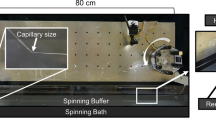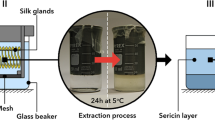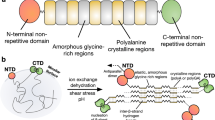Abstract
Spider silk has outstanding mechanical properties despite being spun at close to ambient temperatures and pressures using water as the solvent. The spider achieves this feat of benign fibre processing by judiciously controlling the folding and crystallization of the main protein constituents, and by adding auxiliary compounds, to create a composite material of defined hierarchical structure. Because the ‘spinning dope’ (the material from which silk is spun) is liquid crystalline, spiders can draw it during extrusion into a hardened fibre using minimal forces. This process involves an unusual internal drawdown within the spider's spinneret that is not seen in industrial fibre processing, followed by a conventional external drawdown after the dope has left the spinneret. Successful copying of the spider's internal processing and precise control over protein folding, combined with knowledge of the gene sequences of its spinning dopes, could permit industrial production of silk-based fibres with unique properties under benign conditions.
This is a preview of subscription content, access via your institution
Access options
Subscribe to this journal
Receive 51 print issues and online access
$199.00 per year
only $3.90 per issue
Buy this article
- Purchase on Springer Link
- Instant access to full article PDF
Prices may be subject to local taxes which are calculated during checkout


Similar content being viewed by others
References
Fiber Economics Bureau. Manufactured Fiber Review 2000, Jan 2–53 (Fiber Economics Bureau, Washington, 1999).
O'Brien, J. P., Fahnestock, S. R., Termonia, Y. & Gardner, K. C. H. Nylons from nature: synthetic analogs to spider silk. Adv. Mater. 10, 1185–1197 (1998).
Tirrell, J. G., Fournier, M. J., Mason, T. L. & Tirrell, D. A. Biomolecular materials. Chem. Eng. News 72, 40–51 (1994).
Prince, J., McGrath, K., Digirolamo, C. & Kaplan, D. Construction, cloning, and expression of synthetic genes encoding spider dragline silk. Biochemistry 34, 10879–10885 (1995).
Sun, Y., Shao, Z., Hu, P. & Tu, T. Hydrogen bonds in silk fibroin-poly(acrylonitrile-co-methyl acrylate) blends: FT-IR study. J. Polym. Sci. B 35, 1405–1414 (1997).
Kaplan, D. L., Adams, W. W., Viney, C. & Farmer, B. L. (eds) Silk Polymers: Materials Science and Biotechnology 1–370 (ACS Books, Washington, 1994).
Shear, W. A., Palmer, J. M., Coddington, J. A. & Bonamo, P. M. A Devonian spinneret: early evidence of spiders and silk use. Science 246, 479–481 (1989).
Selden, P. A. Orb-web weaving spiders in the early Cretaceous. Nature 340, 711 (1989).
Heslot, H. Artificial fibrous proteins: a review. Biochimie 80, 19–31 (1998).
Asakura, T. & Kaplan, D. L. Silk production and processing. Encyclop. Agric. Sci. 4, 1–11 (1994).
Kaplan, D., Adams, W. W., Farmer, B. & Viney, C. in Silk Polymers. Materials Science and Biotechnology (eds Kaplan, D., Adams, W. W., Farmer, B. & Viney, C.) 2–16 (American Chemical Society, Washington, 1994).
Seidel, A., Liivak, O. & Jelinski, L. W. Artificial spinning of spider silk. Macromolecules 31, 6733–6736 (1998).
Vollrath, F. & Knight, D. P. Apparatus and method for forming materials. PCT Patent Application PCT/GB00/04489 (1999).
Kaplan, D. L. & Lombardi, S. J. The amino acid composition of major ampullate gland silk (Dragline) of Nephila clavipes (Araneae, Tetragnathidae). J. Arachnol. 18, 297–306 (1990).
Winkler, S. & Kaplan, D. L. Molecular biology of spider silk. Rev. Mol. Biotech. 74, 85–93 (2000).
Guerette, P., Ginzinger, D., Weber, B. & Gosline, J. Silk properties of determined by gland-specific expression of a spider fibroin gene family. Science 272, 112–115 (1996).
Kovoor, J. La soie et les glandes sericigenes des arachnids. Ann. Biol. 16, 97–171 (1977).
Kovoor, J. & Zylberberg, L. Fine structural aspects of silk secretion in a spider. Tissue Cell 14, 519–530 (1982).
Kovoor, J. in Ecophysiology of Spiders (ed. Nentwig, W.) 160–186 (Springer, Berlin/Heidelberg/ New York, 1987).
Vollrath, F., Wen Hu, X. & Knight, D. P. Silk production in a spider involves acid bath treatment. Proc. R. Soc. B 263, 817–820 (1998).
Vollrath, F. & Knight, D. P. Structure and function of the silk production pathway in the spider Nephila edulis. Int. J. Biol. Macromol. 24, 243–249 (1998).
Andersen, S. O. Amino acid composition of spider silks. Comp. Biochem. Physiol. 35, 705–711 (1970).
Work, R. W. & Young, C. T. The amino acid compositions of major and minor ampullate silks of certain orb-web-building spiders (Araneae, Araneidae). J. Arachnol. 15, 65–80 (1987).
Craig, C. L. Evolution of arthropod silks. Annu. Rev. Entomol. 42, 231–267 (1997).
Foelix, R. Biology of Spiders (Oxford Univ. Press, Oxford, 1996).
Vollrath, F. in Biomechanics in Animal Behaviour (eds Domenici, P. & Blake, R. W.) 315–334 (Bios, Oxford, 2000).
Vollrath, F. Spider webs and silk. Sci. Am. 266, 70–76 (1992).
Madsen, B., Shao, Z. & Vollrath, F. Variability in the mechanical properties of spider silks on three levels: interspecific, intraspecific and intraindividual. Int. J. Biol. Macromol. 24, 301–306 (1999).
Vollrath, F. Biology of spider silk. Int. J. Biol. Macromol. 24, 81–88 (1999).
Craig, C. L., Hsu, M., Kaplan, D. & Pierce, N. E. A comparison of the composition of silk proteins produced by spiders and insects. Int. J. Biol. Macromol. 24, 109–118 (1999).
Hayashi, C. Y. & Lewis, R. V. Evidence from flagelliform silk cDNA for the structural basis of elasticity and modular nature of spider silks. Science 287, 1477–1479 (2000).
Hinman, M., Dong, Z., Xu, M. & Lewis, R. W. Spider silk: a mystery starting to unravel. Mater. Res. Soc. Symp. 292, 25–34 (1993).
Hayashi, C. Y., Shipley, N. H. & Lewis, R. V. Hypotheses that correlate the sequence, structure and mechanical properties of spider silk proteins. Int. J. Biol. Macromol. 24, 271–275 (1999).
Kaplan, D. L., Prince, J. T., McGrath, K. P. & Digirolamo, C. M. Construction, cloning and expression of synthetic genes encoding spider dragline silk. Biochemistry 34, 10879–10885 (1995).
Gosline, J. M. et al. in Silk Polymers. Materials Science and Biotechnology (eds Kaplan, D., Adams, W. W., Farmer, B. & Viney, C.) 328–341 (American Chemical Society, Washington, 1994).
Termonia, Y. Molecular modeling of spider silk elasticity. Macromolecules 27, 7378–7381 (1994).
Case, S. T. & Thornton, J. R. High molecular mass complexes of aquatic silk proteins. Int. J. Biol. Macromol. 24, 89–101 (1999).
Gosline, J., Denny, M. & DeMont, M. Spider silk as rubber. Nature 309, 551–552 (1984).
Simmons, A., Michal, C. & Jelinski, L. Molecular orientation and two-component nature of the crystalline fraction of spider dragline silk. Science 271, 84–87 (1996).
Kümmerlen, J., van Beek, J., Vollrath, F. & Meier, B. Local structure in spider dragline silk investigated by two-dimensional spin-diffusion nuclear magnetic resonance. Macromolecules 29, 2920–2928 (1996).
Frische, S., Maunsbach, A. B. & Vollrath, F. Elongate cavities and skin-core structure in Nephila spider silk observed by electron microscopy. J. Microsc. 189, 64–70 (1998).
Work, R. W. Duality in major ampullate silk and precursive material from orb-web-building spiders (Araneae). Trans. Am. Microsc. Soc. 103, 113–121 (1984).
Vollrath, F., Holtet, T., Thogersen, H. & Frische, S. Structural organization of spider silk. Proc. R. Soc. Lond. B 263, 147–151 (1996).
Viney, C., Huber, A. E., Dunaway, D. L., Kerkam, K. & Case, S. T. in Silk Polymers. Materials Science and Biotechnology (eds Kaplan, D., Adams, W. W., Farmer, B. & Viney, C.) 120–136 (American Chemical Society, Washington, 1994).
Mahoney, D. V., Vezie, D. L., Eby, R. K., Adams, W. W. & Kaplan, D. in Silk Polymers. Materials Science and Biotechnology (eds Kaplan, D., Adams, W. W., Farmer, B. & Viney, C.) 196–210 (American Chemical Society, Washington, 1994).
Shao, Z., Wen Hu, X., Frische, S. & Vollrath, F. Heterogeneous morphology in Nephila edulis spider silk and its significance for mechanical properties. Polymers 40, 4709–4711 (1999).
Hijirida, D. H., Do, K. G., Michal, C., Wong, S., Zax, D. & Jelinski, L. W. C13 NMR of Nephila clavipes major ampullate silk gland. Biophys. J. 71, 3442–3447 (1996).
Akai, H. The structure and ultrastructure of the silk gland. Experientia 39, 443–449 (1983).
Knight, D. P. & Vollrath, F. Liquid crystals and flow elongation in a spider's silk production line. Proc. R. Soc. Lond. B 266, 519–523 (1999).
Weiskopf, A., Senecal, K., Vouros, P., Kaplan, D. & Mello, C. M. The carbohydrate composition of spider silk: Nephila edulis dragline. Glycobiology 6, 1703 (1996).
Vollrath, F. & Tillinghast, E. K. Glycoprotein glue beneath a spiders web's aqueous coat. Naturwissenschaften 78, 557–559 (1991).
Kerkam, K., Viney, C., Kaplan, D. & Lombardi, S. Liquid crystallinity of natural silk secretions. Nature 349, 596–598 (1991).
Willcox, P. J., Gido, S. P., Muller, W. & Kaplan, D. L. Evidence of a cholesteric liquid crystalline phase in natural silk spinning processes. Macromolecules 29, 5106–5110 (1996).
Magoshi, J., Magoshi, Y. & Nakamura, S. Crystallization, liquid crystal, and fiber formation of silk fibroin. J. Appl. Polym. Sci. 41, 187–204 (1985).
Nakamae, K., Nishino, T. & Ohkubo, H. Elastic modulus of the crystalline regions of silk fibroin. Polymer 30, 1243–1246 (1989).
Bunning, J. D. & Lydon, J. E. The cellular optical texture of the lyotropic nematic phase of the caesium pentadecafluoro-octanoate (ScPFO) water system in cylindrical tubes. Liquid Cryst. 20, 381–385 (1996).
Donald, A. M. & Windle, A. H. Liquid Crystalline Polymers 1–310 (Cambridge Univ. Press, Cambridge, 1992).
Northolt, M. G. & Sikkema, D. J. Lyotropic main chain liquid crystal polymers. Adv. Polym. Sci. 98, 115–177 (1991).
Knight, D. P., Knight, M. M. & Vollrath, F. Beta transition and stress-induced phase separation in the spinning of spider dragline silk. Int. J. Biol. Macromol. 27, 205–210 (2000).
Riekel, C., Madsen, B., Knight, D. & Vollrath, F. Single fibre X-ray diffraction of spider silk. Biol. Macromol. (in the press).
Palmer, J., Coyle, F. & Harrison, F. Structure and cyto-chemistry of the silk glands of the mygalomorph spider Antrodiaetus unicolor (Aranea, Antrodiaetidae). J. Morphol. 174, 269–274 (1982).
Tillinghast, E., Chase, S. & Townley, M. Water extraction by the major ampullate duct during silk formation in the spider, Argiope aurantia Lucas. J. Insect Physiol. 30, 591–596 (1984).
Vollrath, F., Madsen, B. & Shao, Z. The effect of spinning conditions on the mechanical properties of a spider's dragline. Proc. R. Soc. Lond. (in the press).
Shultz, J. W. The origin of the spinning apparatus in spiders. Biol. Rev. 62, 89–113 (1987).
Tillinghast, E. K., Townley, M. A., Bernstein, D. T. & Gallagher, K. S. Comparative study of orb web hygroscopicity and adhesive spiral composition in three araneid spiders. J. Exp. Zool. 259, 154–165 (1991).
Schildknecht, H., Munzelmann, P., Krauss, D. & Kuhn, C. Über die chemie der spinnwebe. Naturwissenschaften 59, 98–99 (1972).
Vollrath, F. et al. Compounds in the droplets of the orb spider's viscid spiral. Nature 345, 526–528 (1990).
Edmonds, D. & Vollrath, F. The contribution of atmospheric water vapour to the formation and efficiency of a spider's web. Proc. R. Soc. Lond. 248, 145–148 (1992).
Vollrath, F. & Edmonds, D. Modulation of the mechanical properties of spider silk coating with water. Nature 340, 305–307 (1989).
Peters, H. M. Über den Spinnapparat von Nephila madagascariensis (Radnetzspinnen Argiopidae). Z. Naturforsch. 10, 395–404 (1955).
Knight, D. P. & Vollrath, F. Changes in element composition along the spinning duct in a Nephila spider. Naturwissenschaften (in the press).
Gosline, J. M., DeMont, M. E. & Denny, M. W. The structure and properties of spider silk. Endeavour 10, 31–43 (1986).
Vincent, J. F. V. Structural Materials 1–378 (Macmillan, London, 1982).
Shao, Z. & Vollrath, F. The effect of solvents on the contraction and mechanical properties of spider silk. Polymer 40, 1799–1806 (1999).
Magoshi, J., Magoshi, Y. & Nakamura, S. Physical properties and structure of silk: 10. The mechanism of fibre formation from liquid silk of silkworm Bombyx mori. Polym. Comm. 26, 309–311 (1985).
Gamo, T. Genetic variants of the Bombyx mori silkworm encoding sericin proteins of different lengths. Biochem. Genet. 20, 165–177 (1982).
Sehnal, F. & Akai, H. Insect silk glands—their types, development and function, and effects of environmental-factors and morphogenetic hormones on them. Int. J. Insect Morphol. 19, 79–132 (1990).
Hepburn, H. R., Kurstjens, S. P. The combs of honeybees as composite-materials. Apidologie 19, 25–36 (1988).
Henderson, G., Manweiler, S. A., Lawrence, W. J., Tempelman, R. J. & Foil, L. D. The effects of Steinernema capocapsae (Weiser) application to different life stages on adult emergence of the cat flea Ctenocephalides felis (Bouche). Vet. Dermatol. 6, 159–163 (1995).
Zemlin, J. C. A Study Of The Mechanical Behavior Of Spider Silks 1–38 (Clothing and Organic Materials Laboratory Report, US Army Natick Labs, Natick, 1968).
Engster, M. S. Studies on silk secretion in the Trichoptera (F. Limnephilidae). Cell Tissue Res. 169, 77–92 (1976).
Sivinski, J. Prey attraction by luminous larvae of the fungus gnat Orfelia fultoni. Ecol. Entomol. 7, 443–446 (1982).
Hunt, S. Amino acid composition of silk from the pseudoscorpion Neobisium maritimum (Leach): a possible link between the silk fibroins and the keratins. Comp. Biochem. Physiol. 34, 773–777 (1970).
Winkler, S. & Kaplan, D. L. Molecular biology of spider silk. Rev. Mol. Biotech. (in the press).
Mello, C. M., Senecal, K., Yeung, B., Vouros, P. & Kaplan, D. in Silk Polymers. Materials Science and Biotechnology (eds Kaplan, D., Wade, W. W., Farmer, B. & Viney, C.) 67–79 (American Chemical Society, Washington, 1994).
Candelas, G., Candelas, T., Ortiz, A. & Rodriguez, O. Translational pauses during a spider fibroin synthesis. Biochem. Biophys. Res. Commun. 116, 1033–1038 (1983).
van Raaij, M. J., Mitraki, A., Lavigne, G. & Cusack, S. A triple beta-spiral in the adenovirus fibre shaft reveals a new structural motif for a fibrous protein. Nature 401, 935–938 (1999).
van Beek, J. D., Kümmerlen, D., Vollrath, F. & Meier, B. H. Supercontracted spider dragline silk: a solid-state NMR study of the local structure. Int. J. Biol. Macromol. 24, 173–178 (1999).
Yeh, W.-Y. & Young, R. J. Molecular deformation processes in aromatic high modulus polymer fibres. Polymer 40, 857–870 (1999).
Shao, Z., Young, R. J. & Vollrath, F. The effects of solvents on spider silk studied by mechanical testing and single-fibre Raman spectroscopy. Int. J. Biol. Macromol. 24, 295–300 (1999).
Sirichaisit, S., Young, R. J. & Vollrath, F. Molecular deformation in spider dragline silk subjected to stress. Polymers 41, 1223–1227 (1999).
Riekel, C. et al. Aspects of x-ray diffraction on single spider fibers. Macromolecule 24, 179–186 (1999).
Grubb, D. T. & Jelinski, J. W. Fiber morphology of spider silk: the effects of tensile deformation. Macromolecule 30, 2860–2867 (1997).
Fung, Y. C. Biomechanics 1–586 (Springer, Heidelberg, 1981).
Askeland, D. R. The Science and Engineering of Materials (PWS, Boston, 1994).
Yoon, H. N., Charbonneau, L. F. & Calundann, G. W. Synthesis, processing and properties of thermotropic liquid-crystal polymers. Adv. Materials 4, 206–214 (1992).
Thiel, B. & Viney, C. A nonperiodic lattice model for crystals in Nephila clavipes major ampullate silk. Mater. Res. Bull. 20, 52–56 (1995).
Acknowledgements
We thank B. Meier, R. Young, S. Case, J. Kenney, D. LaFollette, C. Craig, D. Kaplan, J. Gosline and H. Coulsey for their perceptive and helpful comments. Our research on spider silk has been funded by the Danish Science Research Council (SNF), the Science Faculty of Aarhus University, the Carlsberg Foundation, the Danish Academic Exchange Programme, the US Army (RDSG), the British Biological and Engineering Research Councils (BBSRC, EPSRC), the European Synchrotron Radiation Facility (ESRF) and the European Science Foundation (ESF). F.V. thanks the director and staff of Mpala Research Centre for their hospitality; D.P.K. thanks the Biological Imaging Centre at Southampton University for technical assistance and we both are grateful to our many collaborators for their help and support.
Author information
Authors and Affiliations
Corresponding author
Rights and permissions
About this article
Cite this article
Vollrath, F., Knight, D. Liquid crystalline spinning of spider silk. Nature 410, 541–548 (2001). https://doi.org/10.1038/35069000
Issue Date:
DOI: https://doi.org/10.1038/35069000
This article is cited by
-
Replicating shear-mediated self-assembly of spider silk through microfluidics
Nature Communications (2024)
-
Engineered spidroin-derived high-performance fibers for diverse applications
Nano Research (2024)
-
A molecular atlas reveals the tri-sectional spinning mechanism of spider dragline silk
Nature Communications (2023)
-
Synthesis of robust underwater glues from common proteins via unfolding-aggregating strategy
Nature Communications (2023)
-
Fluid protein condensates for bio-inspired applications
Nature Reviews Bioengineering (2023)
Comments
By submitting a comment you agree to abide by our Terms and Community Guidelines. If you find something abusive or that does not comply with our terms or guidelines please flag it as inappropriate.



